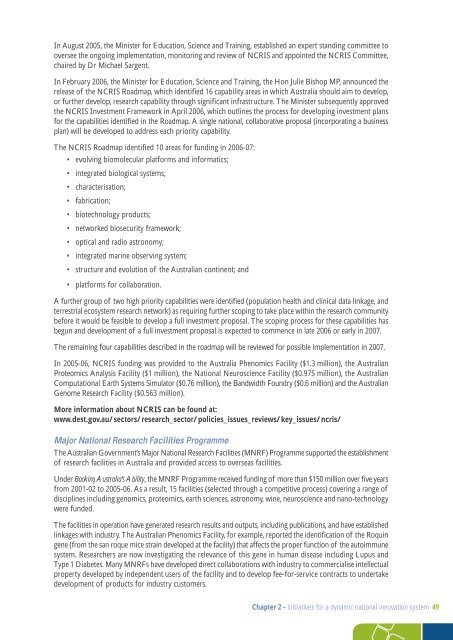The Australian Government's Innovation Report
The Australian Government's Innovation Report
The Australian Government's Innovation Report
Create successful ePaper yourself
Turn your PDF publications into a flip-book with our unique Google optimized e-Paper software.
In August 2005, the Minister for Education, Science and Training, established an expert standing committee to<br />
oversee the ongoing implementation, monitoring and review of NCRIS and appointed the NCRIS Committee,<br />
chaired by Dr Michael Sargent.<br />
In February 2006, the Minister for Education, Science and Training, the Hon Julie Bishop MP, announced the<br />
release of the NCRIS Roadmap, which identified 16 capability areas in which Australia should aim to develop,<br />
or further develop, research capability through significant infrastructure. <strong>The</strong> Minister subsequently approved<br />
the NCRIS Investment Framework in April 2006, which outlines the process for developing investment plans<br />
for the capabilities identified in the Roadmap. A single national, collaborative proposal (incorporating a business<br />
plan) will be developed to address each priority capability.<br />
<strong>The</strong> NCRIS Roadmap identified 10 areas for funding in 2006-07:<br />
• evolving biomolecular platforms and informatics;<br />
• integrated biological systems;<br />
• characterisation;<br />
• fabrication;<br />
• biotechnology products;<br />
• networked biosecurity framework;<br />
• optical and radio astronomy;<br />
• integrated marine observing system;<br />
• structure and evolution of the <strong>Australian</strong> continent; and<br />
• platforms for collaboration.<br />
A further group of two high priority capabilities were identified (population health and clinical data linkage, and<br />
terrestrial ecosystem research network) as requiring further scoping to take place within the research community<br />
before it would be feasible to develop a full investment proposal. <strong>The</strong> scoping process for these capabilities has<br />
begun and development of a full investment proposal is expected to commence in late 2006 or early in 2007.<br />
<strong>The</strong> remaining four capabilities described in the roadmap will be reviewed for possible implementation in 2007.<br />
In 2005-06, NCRIS funding was provided to the Australia Phenomics Facility ($1.3 million), the <strong>Australian</strong><br />
Proteomics Analysis Facility ($1 million), the National Neuroscience Facility ($0.975 million), the <strong>Australian</strong><br />
Computational Earth Systems Simulator ($0.76 million), the Bandwidth Foundry ($0.6 million) and the <strong>Australian</strong><br />
Genome Research Facility ($0.563 million).<br />
More information about NCRIS can be found at:<br />
www.dest.gov.au/sectors/research_sector/policies_issues_reviews/key_issues/ncris/<br />
Major National Research Facilities Programme<br />
<strong>The</strong> <strong>Australian</strong> Government’s Major National Research Facilities (MNRF) Programme supported the establishment<br />
of research facilities in Australia and provided access to overseas facilities.<br />
Under Backing Australia’s Ability, the MNRF Programme received funding of more than $150 million over five years<br />
from 2001-02 to 2005-06. As a result, 15 facilities (selected through a competitive process) covering a range of<br />
disciplines including genomics, proteomics, earth sciences, astronomy, wine, neuroscience and nano-technology<br />
were funded.<br />
<strong>The</strong> facilities in operation have generated research results and outputs, including publications, and have established<br />
linkages with industry. <strong>The</strong> <strong>Australian</strong> Phenomics Facility, for example, reported the identification of the Roquin<br />
gene (from the san roque mice strain developed at the facility) that affects the proper function of the autoimmune<br />
system. Researchers are now investigating the relevance of this gene in human disease including Lupus and<br />
Type 1 Diabetes. Many MNRFs have developed direct collaborations with industry to commercialise intellectual<br />
property developed by independent users of the facility and to develop fee-for-service contracts to undertake<br />
development of products for industry customers.<br />
Chapter 2 - Initiatives for a dynamic national innovation system 49












![[Tam] Uygula[ya] - Bilim, Teknoloji ve Ä°novasyon Politikaları TartıÅma ...](https://img.yumpu.com/36820041/1/184x260/tam-uygulaya-bilim-teknoloji-ve-anovasyon-politikalara-tartaama-.jpg?quality=85)



